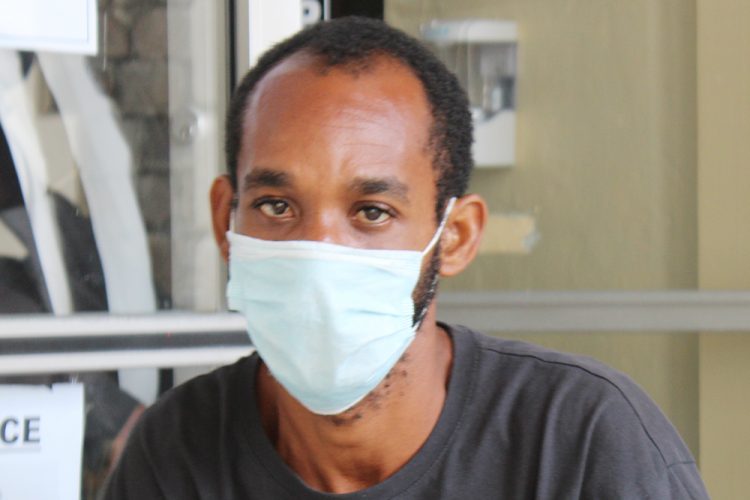Armed gang leader earns 18-year jail sentence

A GUN WIELDER who led an armed trio, tried to rob a Barrouallie man, and chopped him twice in an ensuing struggle; will spend over 18 years in prison.
Julius Gloster, 50, also of Barrouallie, was recently found guilty after a full trial on an indictment which charged him with four very serious offences.
These charges: wounding with intent, attempted robbery, possession of an unlicensed Taurus 9mm semi-automatic pistol, and possession of a firearm with intent to commit an offence, stem from an incident that occurred in the wee hours of the 39th anniversary of Independence of St Vincent and the Grenadines in 2018.
Justice Brian Cottle sentenced Gloster last Friday, February 26 at the High Court. He was assisted by submissions from the prosecution, counsel for the crown Assistant Superintendent of Police (ASP) John Ballah and counsel for the defense, Jemalie John.
The judge, who presided over the trial, summarized the facts that the jury unanimously believed.
These were that on the morning of October 27, at approximately 2:30 am, the victim Lansker Currency was sleeping soundly at his home, having drunk a lot of alcohol at Heritage Square and different Barrouallie establishments the night before.
A man woke him from his slumber, lured him outside with the information that his girlfriend was down the road drunk. Although not believing this at first, Currency decided to investigate. No sooner was he down the steps just outside his home, than an assailant pounced on him, grabbing his shirt and pointing a gun at him, demanding money. When this turned up nothing, the gun holder instructed two individuals with him to go inside the house, to search for valuables there.
Currency decided that things weren’t going to end like this for him, and he grabbed the hand holding the gun, and began to wrestle. While they struggled, the other two men dealt blows to Currency, chopping his head and left arm. The wounded man began fighting “more wild” and the fighting pair landed in a gutter. During the struggle the gun went off.
Currency managed to get the gun away from his assailant, who hightailed it away from the scene with the other robbers in tow.
Bleeding, the victim sought medical attention, and was assisted. He made a report to the police naming Gloster as his attacker.
During his first interview,
instructed by his first lawyer he said, Gloster admitted to the police that he was on the scene and tried to rob Currency, but he said he did not have a gun.
During the trial he attempted to say the police threatened and beat him, but this did not hold up in the jury’s eyes.
While deliberating on the appropriate sentence, Justice Cottle is obligated to have four underlying principles in mind, namely: retribution, deterrence, prevention and rehabilitation.
The victim also provided a statement to the court on the ways in which this crime has affected him post attempted robbery. The 36-year-old tattoo artist says he was significantly impacted psychologically by the assault, and mentioned that the shock was made greater because he is apparently a distant relative to Gloster and has known him since childhood.
The 36-year-old has frequent flashbacks while in his home, and “He credits his survival to his faith in the Almighty to whom he prayed even as he struggled with his armed attacked that day.”
He is scarred from the wounds, and apparently, has pain that flares up from time to time.
Cottle first considered the offence of attempted robbery, for which the maximum is life imprisonment, which is equated to 30 years incarceration.
Sentencing guidelines ought to be used to arrive at a conclusion, and these first require that the judge comes to a starting point, assessing the seriousness and consequences of the offence by reference to the harm caused.
There are three levels of consequences, and this case was placed in the medium level based on the circumstances, while it was placed in level a or the highest level of seriousness.
Some factors determining level of seriousness include “use of weapons, in this case a firearm, bladed weapons were used.
This was a group activity, there was substantial violence meted out, the gun actually went off during the struggle, there was thus a substantial risk of serious harm to the public.”
The court started at 60% of 30 years, or 18 years. No further adjustment was made for aggravating and mitigating features, although it was said that the offence was aggravated by the fact that it occurred at night, while Currency was resting in the comfort of his home.
Gloster has two previous offences for wounding at the magistrate court level. Using a procedure set out by the Court of Appeal, as there are no sentencing guidelines for the offence of wounding with intent, the judge arrived at a sentence of 15 years in prison.
For possession of a firearm with intent to commit and offence the maximum penalty is 25 years imprisonment.
Sentencing guidelines were used in arriving at a decision for this offence. It was placed at the highest level of consequences as the firearm was actually used and may have caused injury. “It is also at the highest level of seriousness because a round was discharged in this group attack,” the judge said.
He noted, “It does not matter in this case that the gun went off during the struggle as opposed to having been deliberately discharged by the prisoner.”
He began at 75% of the maximum. Aggravating and mitigating features already taken into account this would amount to 18 years and nine months.
The offence of possession of a firearm earned Gloster four years in prison.
Nevertheless, all sentences run at the same time as the charges are based on one incident.
Gloster has spent four months and nine days on remand, which must be deducted from his final sentence.









